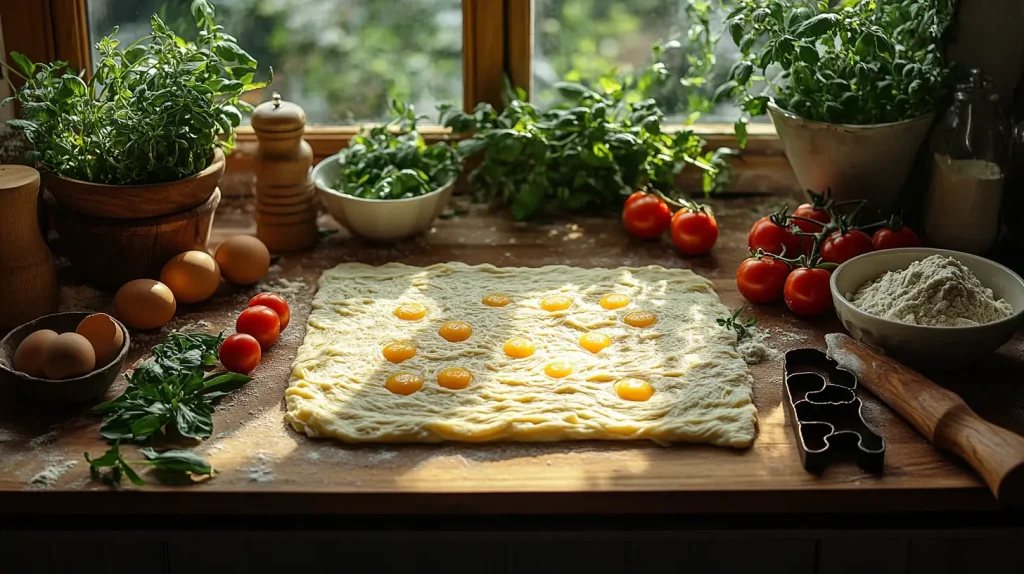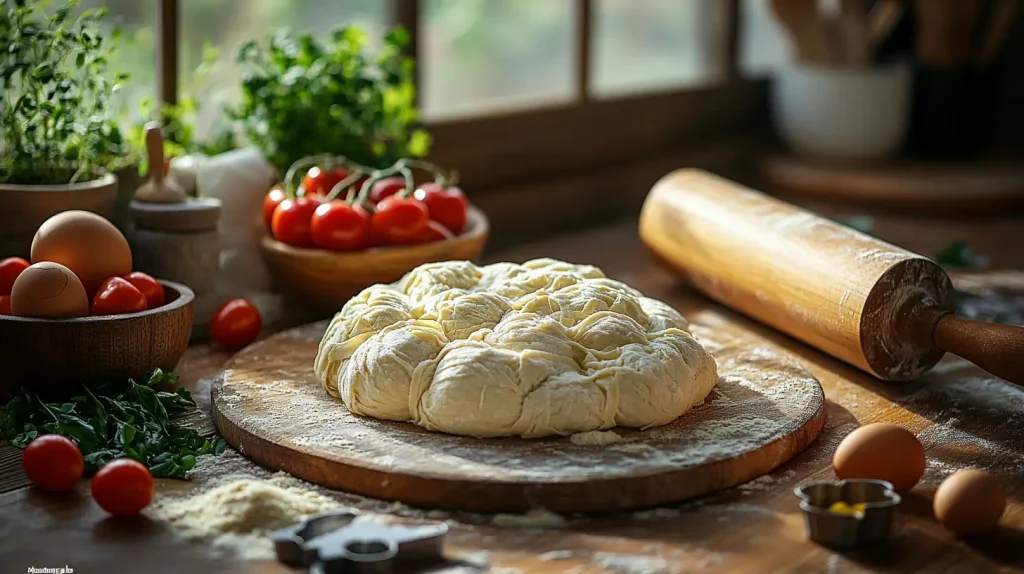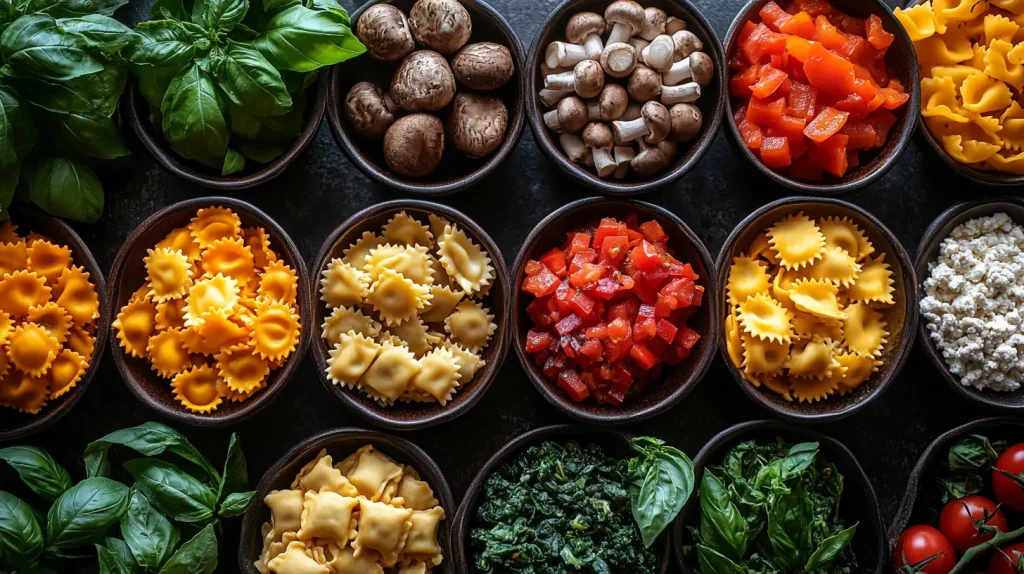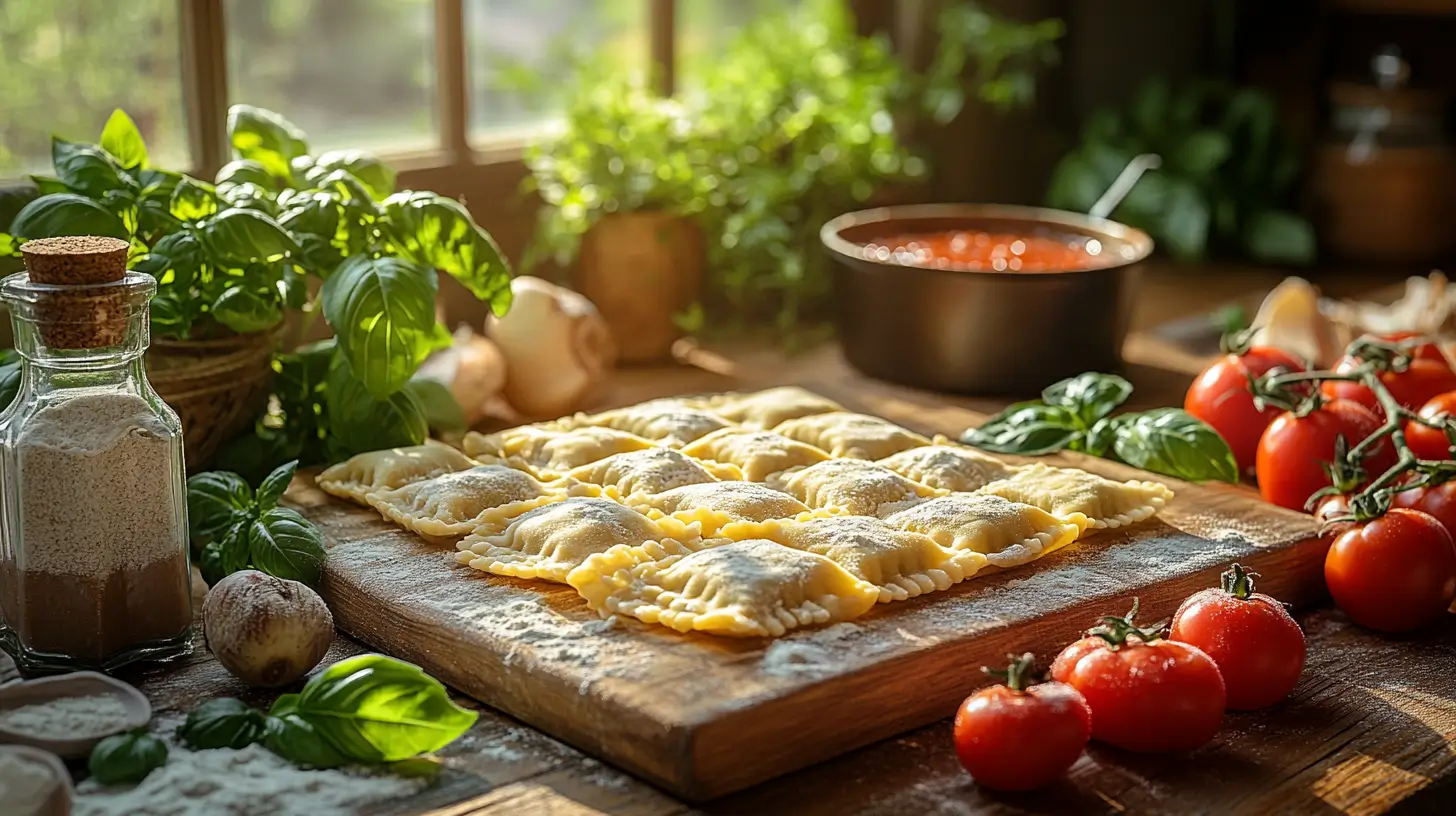I remember the first time I made homemade gluten-free ravioli. It felt like magic in the kitchen. No more worrying about what I could eat. Just two things: gluten-free flour and eggs.
Homemade gluten-free pasta is more than just food. It’s about the fun of cooking. Store-bought pasta can be pricey. But making it yourself is easy and affordable.
There are many gluten-free flour brands to choose from. I’ve found that being creative in the kitchen is key. It makes making gluten-free meals a breeze.
Key Takeaways
- Gluten-free ravioli requires only two main ingredients
- Homemade pasta is more cost-effective than store-bought
- Multiple gluten-free flour brands can be used successfully
- Filling options are incredibly versatile
- Cooking at home allows complete dietary customization
Understanding Gluten-Free Ravioli Basics
Making gluten-free pasta is a special art. It’s loved by those who can’t eat gluten or want a healthier choice, much like the hearty Taco Bake Recipe offers a versatile and satisfying meal option for everyone.

What Makes Gluten-Free Pasta Different
Gluten-free pasta is different from regular pasta. It has:
- No wheat gluten proteins
- A different feel and stretchiness
- Other flours used instead
- Special ways to make it
“Creating gluten-free pasta is an art that requires precision and creativity” – Italian Culinary Expert
Benefits of Homemade Gluten-Free Ravioli
Homemade gluten-free pasta has many benefits:
- You can choose what goes in it
- It’s cheaper than buying it
- You can pick the flavors
- It’s safe from common allergens
Essential Kitchen Tools Needed
You don’t need much to make gluten-free ravioli:
| Tool | Purpose |
|---|---|
| Rolling Pin | Creates thin, even dough |
| Ravioli Cutter | Makes pasta pockets |
| Large Pot | Boils the ravioli |
Try using traditional Italian alternative flours like corn, chestnuts, and chickpeas, which pair wonderfully with a creamy Butternut Squash Ravioli Sauce. They make gluten-free pasta better.
Simple Two-Ingredient Pasta Dough Recipe
Making gluten-free pasta dough is easy. I’ll show you a simple recipe that turns two ingredients into tasty ravioli pasta. Just two main ingredients mix together quickly and easily.

When making gluten-free pasta dough, being precise is key. Here are the essential ingredients you’ll need:
- 1 1/4 cups gluten-free flour blend
- 3 large eggs
Understanding how flours work is important for gluten-free pasta dough. Use a blend that gives structure and flexibility. Aim for a dough that’s not too sticky or too dry.
“The secret to perfect gluten-free pasta dough is finding the right moisture balance.”
Mixing the ingredients right is critical. Mix them slowly, watching the dough’s consistency, much like the care needed when preparing Ritz Cracker Cookies to achieve their perfect texture. If it’s too sticky, add a bit more flour. If it’s too dry, add water a teaspoon at a time.
| Ingredient | Quantity | Purpose |
|---|---|---|
| Gluten-free flour | 1 1/4 cups | Provides structure |
| Eggs | 3 large | Binds ingredients |
This easy gluten-free recipe doesn’t need kneading or long resting times. You can start making your ravioli right after mixing. The result is tender, delicate pasta for your favorite fillings.
Pro tip: You can make your gluten-free pasta dough ahead of time. Store it in the fridge for up to two days. This makes meal prep even easier.
Perfect Ravioli Filling Combinations
Making gluten-free ravioli fillings is like creating art. It lets you be very creative. The right filling can make your dish go from good to great. Let’s look at some tasty combinations to make your ravioli special.
Classic Ricotta and Parmesan Filling
The cheese filling is a favorite for many. Here’s what you should mix:
- 1 cup whole milk ricotta cheese
- ¼ cup shredded mozzarella
- ½ cup grated parmesan
- 2 tablespoons fresh parsley
- ⅛ teaspoon ground nutmeg
Creative Vegetarian Options
Vegetarian fillings are full of flavor. Try these:
- Roasted butternut squash with sage
- Spinach and ricotta with pine nuts
- Roasted red pepper and feta cheese
Meat-Based Filling Ideas
Meat fillings make your dish more filling. Here are some protein-rich options:
- Italian sausage with parmesan
- Shredded chicken with herbs
- Braised beef with rosemary

“The secret to great ravioli is balancing flavors and ensuring your filling isn’t too wet.” – Chef Mario Batali
When making your fillings, drain wet ingredients like ricotta or spinach. This keeps your pasta from getting soggy. Try different mixes to find your top choice!
Step-by-Step Guide to Making Gluten Free Ravioli
Making gluten-free ravioli might seem hard, but it’s doable with the right steps. You can make pasta that’s just as good as the traditional kind. I’ll show you how to make a gluten-free pasta recipe that will wow everyone.
- Pasta roller or rolling pin
- Ravioli cutter or sharp knife
- Clean work surface
- Parchment paper
Use a top-notch gluten-free flour blend like Better Batter or Cup4Cup. These blends have xanthan gum. It helps the dough stick together and gives your pasta the right feel.
“The secret to great gluten-free pasta is patience and technique.” – Gluten-Free Pasta Expert
Here’s how to make your gluten-free pasta:
- Prepare your gluten-free pasta dough
- Divide the dough into small portions
- Roll each portion thin using a pasta roller
- Place filling dollops evenly on the dough
- Fold dough over and seal edges carefully
- Cut into individual ravioli pieces
Pro tip: Work in small batches to prevent the dough from drying out. Make sure to seal the edges well to avoid filling leakage. The whole process takes about 45 minutes to prepare, and just 5 minutes to cook.
By following these steps, you’ll make delicious homemade gluten-free ravioli. It will make your taste buds happy and impress your dinner guests!
Essential Tips for Rolling and Shaping
Learning to make homemade gluten-free ravioli takes skill and patience. I’ll share my best tips for making gluten-free pasta. This will help you make perfect ravioli every time. It’s all about understanding gluten-free dough and using the right techniques.
Achieving the Perfect Dough Thickness
Rolling gluten-free pasta dough needs careful attention. Use a pasta machine or a strong rolling pin for even thickness. Aim for a thickness of 1/8 inch. It should be thin but strong enough for your filling.
- Use rice flour for dusting to prevent sticking
- Roll in small batches to maintain consistent thickness
- Aim for translucent but not transparent dough
Expert Sealing Techniques
Sealing your ravioli right is key to keep the filling inside. Always leave a half-inch border around the filling. Here are some expert tips:
- Remove air pockets by gently pressing around the filling
- Use a fork to crimp edges for extra security
- Brush edges with beaten egg for better adhesion
“The secret to perfect ravioli is in the details of rolling and sealing.” – Pasta Making Expert
My last tip is to be patient. Take your time with each step. Remember, practice makes perfect with these delicate pasta pockets!
Cooking Methods and Timing
Cooking gluten-free pasta needs care and precision. When making your gluten-free ravioli, timing is key. Gluten-free pasta is delicate and can break or get mushy if not handled gently.
Here are some important cooking techniques for perfect gluten-free ravioli:
- Use a large pot with gently boiling salted water
- Cook for precisely 3-4 minutes
- Watch for ravioli to float to the surface
- Remove with a slotted spoon to avoid damage
Pro tip: Avoid vigorous boiling, which can cause delicate gluten-free ravioli to burst open.
Cooking gluten-free ravioli is different from regular pasta. Keep a close eye on it. Cooking times can change based on dough thickness and flour blend used.
“Patience is key when cooking gluten-free pasta – gentle treatment ensures the best texture and flavor.”
It’s important to think about how to store your gluten-free ravioli. Uncooked ravioli can be frozen for up to 3 months. Cooked ravioli should be eaten right away for the best taste and texture.
| Cooking Detail | Recommendation |
|---|---|
| Cooking Time | 3-4 minutes |
| Water Temperature | Gentle simmer |
| Portion Size | 10-12 large or 20-24 small ravioli |
Remember, the more you practice, the better you’ll get at cooking gluten-free pasta. Each try will help you improve your skills and make delicious ravioli at home.
Sauce Pairings and Serving Suggestions
Choosing the right sauce can make your gluten-free pasta dish special. Gluten-free pasta sauces are key to making homemade ravioli taste amazing.
Traditional Italian Sauce Selections
For authentic Italian dishes, pick classic sauces. Here are some top choices:
- Marinara: A bright tomato sauce with fresh basil
- Alfredo: Creamy and rich, great for cheese-filled ravioli
- Pesto: A green sauce with fresh basil and pine nuts
Modern Sauce Alternatives
New gluten-free pasta sauces can add exciting tastes. Try these modern options:
- Avocado pesto: Creamy and dairy-free
- Roasted red pepper sauce
- Butternut squash cream sauce
Here are some serving tips:
- Garnish with fresh basil
- Sprinkle shredded Parmesan
- Drizzle high-quality olive oil
“The right sauce can transform a simple meal into a gourmet experience.”
Try different sauces to find your favorite. Serve your ravioli with gluten-free meatballs or garlic bread for a full meal.
Storage and Make-Ahead Options
Storing gluten-free pasta right is key to keeping your homemade ravioli tasty. Make-ahead meals are a lifesaver for those with busy schedules.
Keeping your gluten-free ravioli fresh is all about the right storage. Here are some tips:
- Refrigerator Storage:
- Uncooked ravioli stays good for up to 2 days
- Store in an airtight container with parchment paper between layers
- Keep it cold at 40°F or below
- Freezing Techniques:
- Freeze uncooked ravioli for up to 3 months
- Put them on a baking sheet lined with parchment paper
- Freeze until solid, then move to freezer-safe containers
Pro tip: When cooking frozen ravioli, add 1-2 minutes to the usual cooking time. This ensures they’re hot all the way through.
“The secret to great make-ahead gluten-free meals is proper preparation and storage” – Gluten-Free Cooking Expert
| Storage Method | Duration | Best Practices |
|---|---|---|
| Refrigerator (Uncooked) | Up to 2 days | Use airtight container, separate layers |
| Freezer (Uncooked) | Up to 3 months | Freeze on baking sheet, transfer to containers |
| Cooked Ravioli | 3-4 days | Store with a little pasta water to prevent sticking |
For cooked ravioli, store in an airtight container with a bit of pasta water. This stops them from sticking together. When reheating, use gentle methods like steaming or a light pan toss. This helps keep the texture and flavor just right.
Conclusion
Making homemade gluten-free ravioli is more than cooking. It’s a fun adventure that makes eating special. You’ll discover new flavors and ideas in your kitchen.
Homemade gluten-free ravioli is easy and flexible. With a few ingredients and practice, you can make pasta that’s as good as any restaurant. You can choose what goes inside and enjoy real Italian food that fits your diet.
Every time you make gluten-free ravioli, you win. It shows that you can have great taste without giving up on your diet. You can try different fillings, like ricotta or veggies, and make your ravioli special.
Start making gluten-free pasta with confidence. Every ravioli you make helps you grow as a cook. You’ll try new tastes and enjoy meals that are good for you. Your kitchen is full of possibilities.
FAQ
Is it difficult to make gluten-free ravioli at home?
No, it’s not hard at all! You just need gluten-free flour and eggs. The steps are simple. Soon, you’ll make ravioli that’s better than store-bought.
What type of flour works best for gluten-free ravioli dough?
Use a gluten-free flour blend made for pasta. It has rice flour, cornstarch, and more. This mix gives the dough the right feel and stretch.
How can I prevent my gluten-free ravioli from falling apart while cooking?
Make sure to seal them well. Leave a 1/2-inch border around the filling. Press out air and crimp the edges with a fork. Cook them gently in simmering water to avoid bursting.
Can I freeze homemade gluten-free ravioli?
Yes, you can! Freeze them for up to 3 months. First, freeze them on a baking sheet. Then, put them in a freezer-safe container. Cook them for 1-2 minutes longer when you thaw them.
What are some creative filling ideas for gluten-free ravioli?
There are so many ideas! Try ricotta and Parmesan, roasted butternut squash with sage, or spinach and feta. You can also use leftover meats. Get creative and mix things up!
How long can I store fresh, uncooked ravioli?
You can keep them in the fridge for 2 days. But freezing is best for longer storage. It keeps them fresh longer.
Do I need special equipment to make gluten-free ravioli?
No, you don’t need special tools. Just a rolling pin, a cutter or knife, and a pot for boiling. A pasta machine helps, but it’s not required.
What sauces work well with gluten-free ravioli?
Marinara, alfredo, and pesto are great choices. For something new, try avocado pesto or a dairy-free sauce. Pick a sauce that goes well with your filling.

